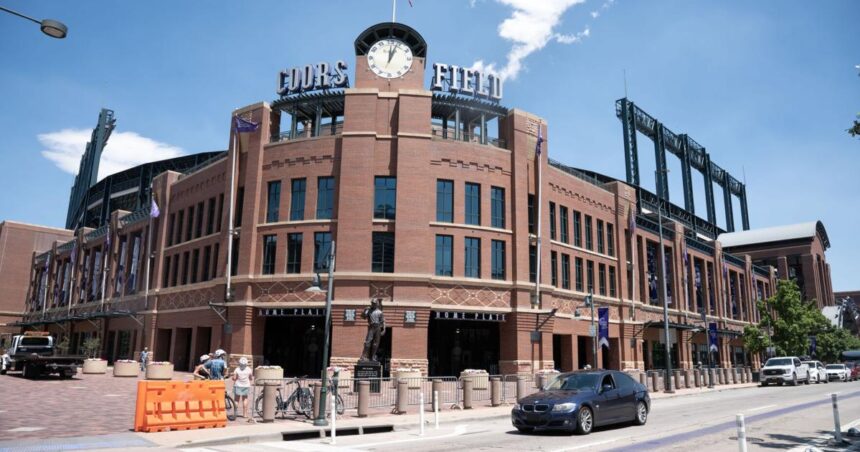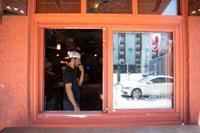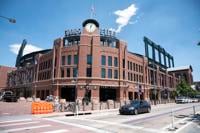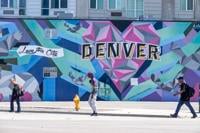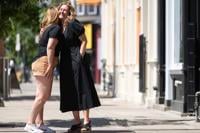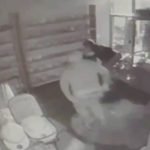Mexico City Lounge has been a staple of Denver’s Ballpark neighborhood long before Coors Field was built two blocks away. Owners throughout its 65 years in business have watched the area go through many seasons.
But business leaders and others, including the restaurant’s owner, said they are tired of sitting in the dugout.
They want to take more control of Ballpark’s future amidst years of frustrations with city management.
Their proposed solution? A taxing district whose revenue would be used directly to improve the area.
Next week, members of the community will try again to convince City Council to allow Ballpark residents to vote on becoming an official tax district, pointing to the area’s needs, which they said have grown during the pandemic.
“It’s always sort of been a challenging area,” Mexico City Lounge’s Owner Candice Pineda said. “COVID is when it really kind of got worse.”
Cars were damaged or broken into at Mexico City Lounge’s parking lot as Ballpark became a hotspot for homeless camps, Pineda said, and people who appeared to be homeless would lock themselves in the restaurant’s bathroom, while others were violent.
Police often took too long to respond, she added, and trash accumulated outside its doors.

Inside Mexico City Lounge in downtown Denver on Friday, June 28, 2024. (Stephen Swofford, Denver Gazette)
Owners are limited in their ability to de-escalate situations alone or maintain the area around their businesses, according to the district proposal.
Relying on the city also hasn’t proven enough.
Now the area’s property owners hope a district could offer more support.
While Denver’s new city administration under Mayor Mike Johnston has significantly helped the area by sweeping encampments, Pineda said, it hasn’t completely solved the issues, either.
“There’s just a lot of ways that we can work together to be innovative and really create some much needed vibrancy,” she said.
Two strikes but not out
Much of downtown Denver is covered in improvement districts, but not the area around Coors Field.
Such a district is run by a board of business or property owners who manage services, such as beautification projects or private security to meet the needs of the neighborhood.
In order to become one, it has to be approved by City Council and by voters.
The official designation allows the area to collect an extra tax based on the assessed value of properties within its boundaries to create a revenue stream for funding improvements.
Ballpark is surrounded by three business improvement districts in RiNo, Upper Downtown and Five Points, making it a “donut hole” that is lacking services, according to a city presentation shown at a committee meeting earlier this month.
Ballpark’s business leaders and others have already tried and failed to become a district twice.
The first attempt began in 2016.
That year, they vied to become a business improvement district — which taxes the commercial properties within its boundaries — like the other neighborhoods around them, but city officials at the time believed it wasn’t viable for only 200 businesses to fund the area’s ambitions.
They launched another initiative in 2019, but as a general improvement district to tax both business and residential properties within the neighborhood.
Then COVID-19 came.
As the pandemic delayed efforts, the neighborhood’s problems worsened.
Some businesses, their employees and customers increasingly didn’t feel safe because of the rise in homelessness and violent crime. And with it, Ballpark’s reputation sank.
Today, it’s become more essential to invest in the area and avoid urban decay, advocates of the proposed district told the Denver Gazette.

Diego Villanueva talks with coworkers in the window of Mexico City Lounge in downtown Denver’s Ballpark neighborhood on Friday, June 28, 2024. The area’s leaders are working to become a tax district again after repeated attempts. (Stephen Swofford, Denver Gazette)
A complex district to set up
“I’ve done special districts for 23 years,” Jamie Giellis, a neighborhood-revitalization consultant with Denver-based Centro Inc. who advised the Ballpark team, told City Council members June 24. “This is probably, hands down, the most complicated one I’ve ever done.”
One of the main reasons is the makeup of Ballpark.
About a third of the neighborhood is owned by tax-exempt organizations due to the proliferation of social service nonprofits based in the area.
It has the highest concentration of social services in the state, according to the nonprofit neighborhood organization Ballpark Collective.
Even the area’s namesake is tax-exempt: Coors Field.
Ballpark’s composition is a picture of how its identity is still grappling with the remnants of its dicey past and the flashy developments surrounding the baseball stadium.
The neighborhood’s roots date back to the silver-and-gold mining boom that put Denver on the map.
Buildings, warehouses and factories went up around the busy railroad tracks during its peak, according to the Ballpark Collective, and it attracted immigrants for over a century from Italy, China, Ireland, Japan and Mexico.
When the Silver Crash of 1893 sparked a recession and exodus of miners, the neighborhood saw an influx of speakeasies, brothels and pawn shops. It was a “skid row” for decades, the Ballpark Collective said on its website. Many buildings were torn down in the 1980s to make way for parking lots to serve downtown’s office skyscraper boom.
Then Coors Field opened in 1995.

Cars drive past Coors Field on Friday, June 28, 2024. The Ballpark neighborhood’s namesake is tax-exempt and normally wouldn’t have to pay into a general improvement district’s budget, but the Colorado Rockies are voluntarily offering to contribute to help make the district a reality, a district proposal shows. (Stephen Swofford, Denver Gazette)
Urban planner Karle Seydel strongly advocated bringing a baseball stadium to the area he called North Downtown, or NoDo, at the time to revitalize downtown. It worked, and the baseball stadium sparked investment in the surrounding neighborhood with developments like McGregor Square.
Now Ballpark is made up of nonprofits, parking lots, empty historic buildings, residential properties and a busy dining and nightclub scene around the stadium.
The combined tax collected from residential and business properties in the area would generate $1.3 million for the proposed district’s first year in 2025, if approved.
In a rare agreement, the Ballpark District got the support of some tax-exempt organizations, including the Colorado Rockies and Denver Rescue Mission, which may contribute to the budget on top of the property tax revenues.
The Rockies did not respond when asked for comment.
Those contributions could total approximately an additional $700,000, Giellis said at a committee meeting earlier this month. If agreements are signed, the district is considering asking tax-exempt property owners to contribute what they would as a taxable property.
Denver Rescue Mission (representing the area’s service providers) and the Colorado Rockies’s vice president Kevin Kahn will also have a seat on the proposed district board.
Having tax-exempt organizations sitting on a tax district board is an odd feature for a district, Giellis explained, but it’s also a sign of how those stakeholders also want to invest in better structure for the Ballpark area.
“When the Mission has the opportunity to collaborate with area businesses leaders to improve our city, and in this case the Ballpark District, we are going to take advantage of it,” a Denver Rescue Mission spokesperson said in an email.
Where the taxing district’s revenue would go
A majority of the district’s budget would go toward hiring safety ambassadors trained to de-escalate situations and direct people who may need social services.
The proposed district estimates it would cost $750,000 and is considering hiring Block by Block, which has unarmed “ambassadors” trained in handling mental health crises and being a resource for property owners to call when homeless people are disrupting their business or if workers wish to be escorted to their car.
The organization services urban neighborhoods across the country, including downtown Boulder.
About $300,000 a year would go toward cleaning and infrastructure projects.
It includes pressure washing buildings, removing litter, planting trees, expanding trash cans, adding signs with Ballpark branding and funding art and holiday decorations.
Conditions have improved under Johnston’s homelessness initiatives and encampment sweeps, said Marti Page, the property owner of two buildings in Ballpark since 2016 and a member of the proposed board. But the problems may not have festered as much from poor city management over the years if the area had a district in place, Page said.
“There would have been more organization to combat some of these challenges,” Page said.
Page said she’s “very bullish” on Ballpark despite its problems. She owns the Asterisk event venue on Park Ave. and the building with the “Love this City” mural on North Broadway.
But telling people what neighborhood her properties are in has been confusing.
“I always just throw out three or four neighborhoods, and then ultimately say, ‘Oh, and we’re four blocks from Coors Field,’” Page said.
A district could have more power in shaping Ballpark’s identity, she said.

People walk past a mural at the intersection of Park Avenue West and Broadway in downtown Denver on Friday, June 28, 2024. The building is owned by Marti Page, who said she hopes making Ballpark an official tax district could better all of downtown’s neighborhoods. (Stephen Swofford, Denver Gazette)
“Raising an awareness of the fact that our neighborhood exists will benefit my properties and the overall neighborhood,” she said.
And if the district doesn’t pass again, Page said she worries how Ballpark’s problems could continue spilling into other neighborhoods downtown.
“Because it’s so central to downtown,” Page said, “if you have this district that doesn’t have that similar kind of organization, it will undermine every other surrounding district.”
Support from more stakeholders than before
This is the first time resident Bill Smythe, a technology consultant living in Ballpark for about 16 years, said he heard about efforts to create a district.
He moved to the neighborhood to be close to Interstate 25, baseball games and concert venues. Smythe not only lives in the area, but works there, too.
“I love the neighborhood,” Smythe said, “Over the past few years … it’s been dinged up a little bit.”
Smythe said the city neglected the area, compelling the community to band together and press for solutions themselves.
“You persevere through those kinds of things,” Smythe said. “When the opportunity to support this special district came up, everybody seemed to collectively jump on board, recognizing it as a great opportunity.”
The district proposal collected more than 220 petition signatures from businesses, property owners and residents for the effort.

Candice Pineda, owner of Mexico City Lounge, left, hugs Lisa Franz, owner of Frank’s Gentlemen’s Salon, outside their respective shops on Friday, June 28, 2024. Many business owners have vocalized support to make Ballpark a general improvement district after years of discussions. (Stephen Swofford, Denver Gazette)
It already passed the city’s Business, Arts, Workforce, Climate & Aviation Services Committee hearing without opposition. On June 24, City Council approved a public hearing to decide on the Ballpark District on July 8 with two votes against it.
Councilwoman Shontel Lewis of District 8, which covers Central Park and Park Hill and who voted against it, said she wants more details on the proposal, such as ensuring board representation includes the entire neighborhood and the total number of residential and commercial properties in the area.
If approved at the July 8 meeting, a TABOR election will be held Nov. 5 when the area’s residents and property owners can vote on whether they want to create a district.
So could it actually happen?
A new city administration promising to revitalize downtown reignited hope, several people backing the proposed district said.
Previous attempts were led mostly by business owners. Today, the proposal includes support from residents, nonprofits, city officials and the Rockies, they said. The range of voices, the proponents said, is its biggest advantage yet.
This time, they said, its bases are loaded.




